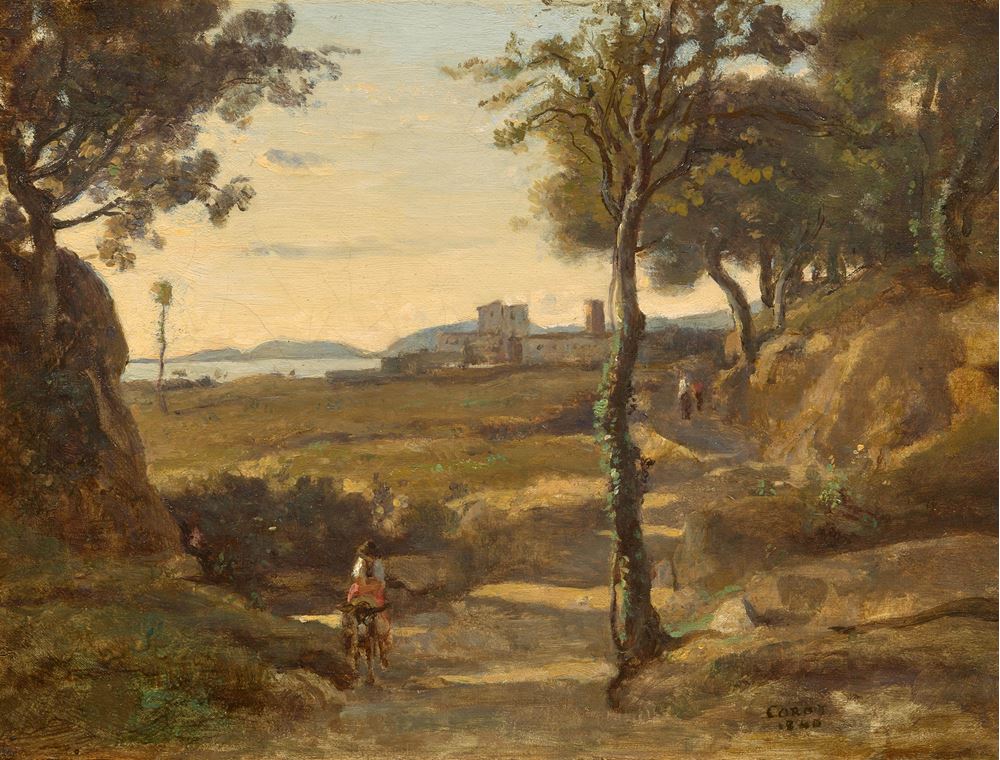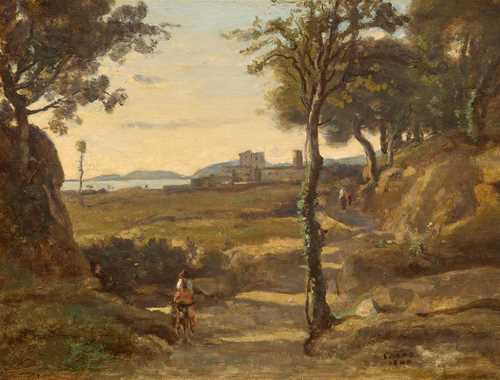
Lotto 3212* - A206 Dipinti del XIX secolo - venerdì, 22. settembre 2023, 16h00
JEAN-BAPTISTE CAMILLE COROT
- Sold by the artist 5.2.1873.
- Fremyn collection, sold 10.5.1876.
- Collection of M. Lolley, from 10.5.1876.
- Collection of M. Le Roy, from 1880.
- Sale, Le Roy collection, 13.5.1882, Lot 4.
- Collection of Jean Dollfus (1823–1911) (label verso), acquired at the above auction.
- Sale, George Petit, Paris, 2.3.1912, Lot 20.
- Collection of Adrien Dollfus (1858–1921), acquired at the above auction.
- By descent, collection of Jean Dollfus (1891–1983).
- By descent, private collection, Germany.
Exhibited:
- Paris 1953, Exposition Nature et Peinture. Galerie Daber, 4.11.–28.11.1953, No. 3. (label verso).
- Paris 1971, Galerie Schmit, 21.5.–12.6.1971, No. 25. (label verso).
Literature:
Alfred Robaut: L’oeuvre de Corot, Paris 1965, vol. II, p. 224, No. 638 (with ill, p. 225).
This atmospheric landscape painting, executed with a playful lightness of touch, is striking for the harmonious earthy tones and rapid brushwork used by Corot in his depiction of the Roman Campagna bathed in light. The painting was produced in 1840 and incorporates impressions of the Italian landscape which Corot had gathered during his numerous journeys to Italy from 1825 onwards. The title "Souvenir d'Italie" refers to the extraordinary group of works within Corot's oeuvre, in which, on his return to the studio, he recreated his extensive travels in Italy using the numerous drawings and oil sketches he had made in situ in the open air. This painting, dated 1840 by Corot in the lower right-hand corner, was probably produced after such landscape studies, made during his second trip to Italy in 1834, which lasted about six months. This journey took him through northern Italy and Tuscany via Rome and on to the south of the country.
This painting demonstrates the ground-breaking character of Corot's landscape painting, which many fellow artists would use as a guide in the course of the 19th century. The composition is a feat of virtuosity. Rock formations and individual trees frame the view of this vast landscape. The view is punctuated only by a single tree in the foreground. This lends depth to the painting and divides it in line with the Golden Section: to the right of the tree a path winds its way towards the town, while to the left the landscape opens up with the town and the lake in the background. This well-conceived compositional approach, especially with the tree in the foreground creating depth, proved to be a pictorial technique that was readily adopted by the Impressionists towards the end of the century. The ingenious play of light and shade, which primarily determines the foreground and middle ground of the picture, also points to the radical changes in landscape painting that were to follow in the second half of the century.
An old label on the back of the painting locates the scene as being in the vicinity of the papal summer residence Castel Gandolfo, a few dozen kilometres southeast of Rome on Lake Albano. Indeed, this painting could be a view of the picturesque Castel Gandolfo, which had been a popular destination for the inhabitants of Rome since the 18th century and had also attracted other artists and literary figures, such as Johann Wolfgang von Goethe, who stayed in Castel Gandolfo in October 1787. The Souvenir d'Italie by Corot offered here, painted during a phase in which he reflected artistically on his travels in Italy, is therefore an extremely interesting combination of painting and style: while the dynamic, effortless manner suggests a picture painted in Italy ‘d'après nature et en plein air’, the dating and the complex composition of the painting indicate that it was executed in Corot's studio.
The provenance of the present landscape painting by Corot is also extremely exciting. From the 1880s onwards, this painting was owned by the descendants of the influential Alsatian factory owner Jean Dollfus (1800–1887), who was mayor of Mulhouse from 1863 to 1869, as well as senior president of the German Reichstag from 1881 to 1884. The painting was also shown in two important exhibitions of pre-impressionist landscape painting. In 1953, the work was included in the exhibition Nature et Peinture at the Galerie Alfred Daber in Paris, as attested by a label on the back of the painting. In 1971, the work was shown in the Corot Retrospective at one of the most important and well-known galleries in Paris, the premises of the highly esteemed art expert and collector Robert Schmit, a fact also indicated by a label on the back of the painting. This exceptional provenance underlines the outstanding quality of the artwork offered here.
CHF 80 000 / 100 000 | (€ 82 470 / 103 090)
Venduto per CHF 75 000 (incl. premio dell'acquirente)
Non si assume alcuna responsabilità per la correttezza di queste informazioni.



